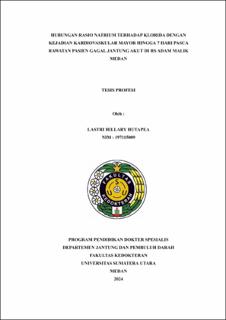Rasio Natrium terhadap Klorida dengan Kejadian Kardiovaskular Mayor Hingga 7 Hari Pasca Rawatan Pasien Gagal Jantung Akut Di Rs Adam Malik Medan
The Relationship Between Sodium To Chloride Ratio With 7 Days of Major Cardiovascular Events Of Acute Heart Failure Patient In Haji Adam Malik General Hospital

Date
2024Author
Hutapea, Lastri Hillary
Advisor(s)
Hasan, Refli
Haykal, Teuku Bob
Metadata
Show full item recordAbstract
Objective:
Acute heart failure (AHF) can be defined as a critical medical condition resulting
from the heart's inability to pump blood efficiently. A key aspect in the
management of AHF is predicting major adverse cardiovascular events (MACEs)
during the "acute phase," with monitoring laboratory findings considered as a
potential prognostic tool. This study aims to determine the relationship between
the sodium/chloride (Na/Cl) ratio and the risk of MACEs in AHF patients during
the first 7 days of hospitalization.
Methods:
This observational, single-center, cross-sectional study was conducted at Adam
Malik Hospital, Medan, Indonesia, from May to October 2024. The researchers
included AHF patients with complete Na/Cl ratio data (with a cut-off of 1.3) at
initial presentation, who were subsequently hospitalized for at least 7 days to
evaluate the risk of MACEs. Statistical analysis was performed using SPSS
version 24.0.
Results:
We included a total of 50 AHF patients (70.0% male) with a mean age of 58.98 ±
11.42 years into the final analysis, with 80.0% were diagnosed with acute de novo
heart failure (ADHF). A higher proportion of MACEs was observed in the group
with an elevated Na/Cl ratio (76.3% vs 33.3%; P=0.012). However, no such
association was found when analyzing sodium or chloride levels individually, nor
was there any correlation with in-hospital mortality (P>0.05). Interestingly,
higher Na/Cl ratios and lower chloride levels were found in the MACE group
(P<0.05). Diagnostic performance analysis showed that the Na/Cl ratio had a
sensitivity of 63.6% and specificity of 64.7%, respectively.
Conclusion:
The Na/Cl ratio is a reasonably reliable parameter for predicting MACEs, as an
increase in this metric indicates a higher risk of MACEs
Collections
- Master Theses [107]
